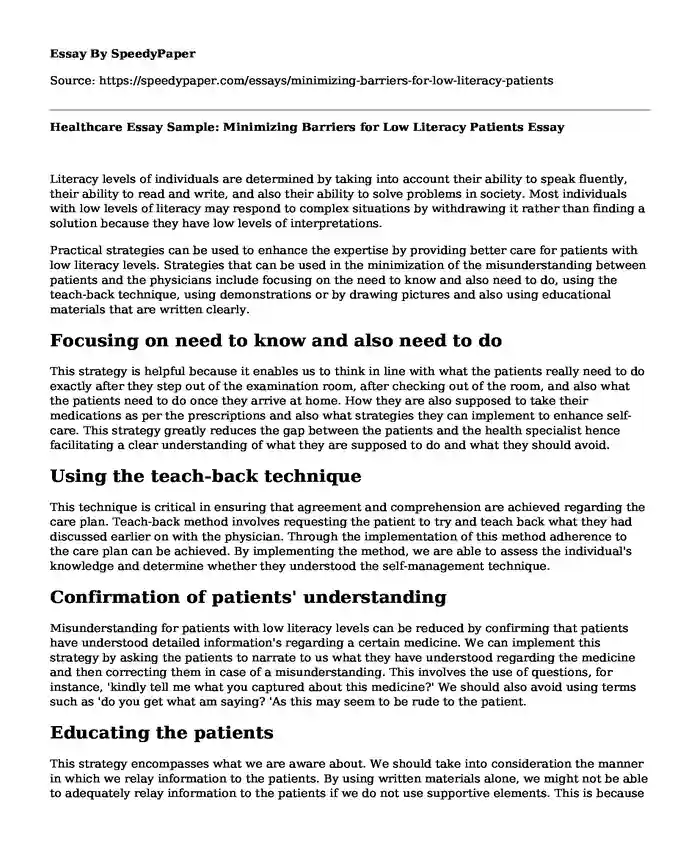
| Type of paper: | Essay |
| Categories: | Healthcare |
| Pages: | 3 |
| Wordcount: | 823 words |
Literacy levels of individuals are determined by taking into account their ability to speak fluently, their ability to read and write, and also their ability to solve problems in society. Most individuals with low levels of literacy may respond to complex situations by withdrawing it rather than finding a solution because they have low levels of interpretations.
Practical strategies can be used to enhance the expertise by providing better care for patients with low literacy levels. Strategies that can be used in the minimization of the misunderstanding between patients and the physicians include focusing on the need to know and also need to do, using the teach-back technique, using demonstrations or by drawing pictures and also using educational materials that are written clearly.
Focusing on need to know and also need to do
This strategy is helpful because it enables us to think in line with what the patients really need to do exactly after they step out of the examination room, after checking out of the room, and also what the patients need to do once they arrive at home. How they are also supposed to take their medications as per the prescriptions and also what strategies they can implement to enhance self-care. This strategy greatly reduces the gap between the patients and the health specialist hence facilitating a clear understanding of what they are supposed to do and what they should avoid.
Using the teach-back technique
This technique is critical in ensuring that agreement and comprehension are achieved regarding the care plan. Teach-back method involves requesting the patient to try and teach back what they had discussed earlier on with the physician. Through the implementation of this method adherence to the care plan can be achieved. By implementing the method, we are able to assess the individual's knowledge and determine whether they understood the self-management technique.
Confirmation of patients' understanding
Misunderstanding for patients with low literacy levels can be reduced by confirming that patients have understood detailed information's regarding a certain medicine. We can implement this strategy by asking the patients to narrate to us what they have understood regarding the medicine and then correcting them in case of a misunderstanding. This involves the use of questions, for instance, 'kindly tell me what you captured about this medicine?' We should also avoid using terms such as 'do you get what am saying? 'As this may seem to be rude to the patient.
Educating the patients
This strategy encompasses what we are aware about. We should take into consideration the manner in which we relay information to the patients. By using written materials alone, we might not be able to adequately relay information to the patients if we do not use supportive elements. This is because most patients prefer to obtain essential messages from their physician which are supported by circulars.
When we are tailoring our messages to patients, we should often focus on what they need to know first and also on what they need to understand; we should not give up on undertaking exercises that are tiresome especially those of us in the medical related field.
It is also critical for us to note that patients who have low levels of literacy most often tend to ask very few questions and therefore it majorly relies on us as the staff to spot on the needs of a patient and to determine where they understand their responsibilities. We should also encourage the patients to bring along some of the family members or friends'. This is because family members usually ensure that questions are asked, and this facilitates remembrance of what they have discussed with the physician.
Using visuals
Pictures and demonstrations often help us to improve the understanding of patients with literacy levels that are low. By using drawings, the patients are able to remember more. Physicians tend to draw pictures that are less complicated compared to most health care drawings which tend to be more complex even to be figured out; this strategy enhances understanding. We can also implement the culture of using demonstrating to illustrate how thing tends to work rather than simply narrating to them since it's much simpler for the patients to grasp.
Using plain language
We should use plain language that is simpler for the patients to understand and also the use of alternatives words should be encouraged to ensure that the patients understand thus reducing the communication barrier.
Giving tips to clinicians
We can also minimize barriers among the clinicians and the patients by giving them several tips which includes the limitation of the information that they give to the patients this will enable the patients to remember only the key points and focus on them, being specific and solid to certain points only and if there is involvement of actions we should concentrate on every important point. We are able to assess the individual's knowledge and determine whether they understood the self-management technique.
Cite this page
Healthcare Essay Sample: Minimizing Barriers for Low Literacy Patients. (2022, Mar 12). Retrieved from https://speedypaper.net/essays/minimizing-barriers-for-low-literacy-patients
Request Removal
If you are the original author of this essay and no longer wish to have it published on the SpeedyPaper website, please click below to request its removal:
- Case Study on Word of Mouth Marketing
- Free Essay Example on Fibromyalgia
- Free Essay on the Movie Fight Club Research
- Advertisement Analysis Essay Sample
- Strategic Investment Appraisal, Free Essay Example
- Essay Sample on the Truth and Uncertainty in the Rashomon Film
- Burning Sensation in Stomach Walls: Patient History - Case Study
Popular categories




